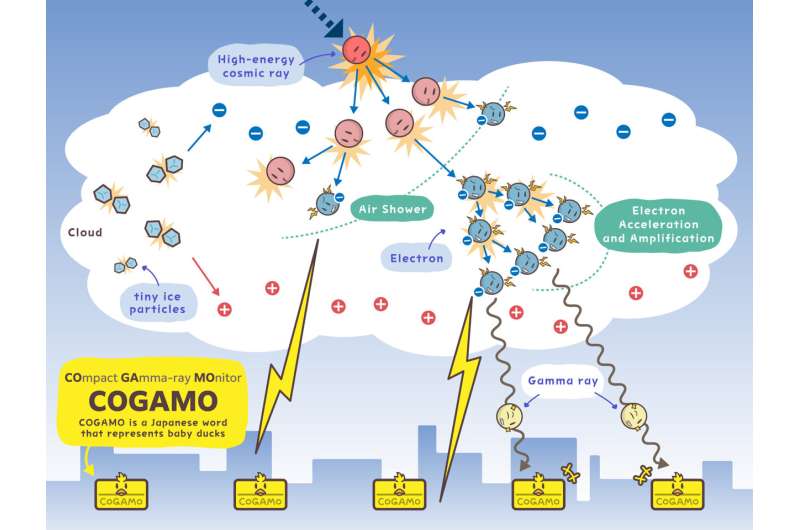This article has been reviewed according to Science X's editorial process and policies. Editors have highlighted the following attributes while ensuring the content's credibility:
fact-checked
peer-reviewed publication
trusted source
proofread
Citizen scientists observe gamma-ray glows that may reveal origin of lightning

A research group led by Kyoto University, in cooperation with a network of citizen supporters, has collected data from gamma-ray glows—a phenomenon where high-energy photons crash to the ground from rolling thunderclouds—that may illuminate lightning's origins.
Factually, thunder is caused by lightning. As Mark Twain wrote in 1908, "Thunder is good, thunder is impressive; but it is lightning that does the work." But what causes lightning still remains a mystery.
In the collaborative Thundercloud Project, recording devices called "Cogamo"—short for compact gamma-ray monitor—are installed at each supporter's home in a multi-point observation network in Kanazawa near the Japan Sea coast. In addition to environmental high-energy radiation data, Cogamo record and transmit real-time temperature, humidity, and illumination data to a web server.
"Gamma rays indicate the existence of a strong electric field in thunderstorms, where electrons can be accelerated to relativistic speeds," says project leader Teruaki Enoto of KyotoU's Department of Physics. Their paper "Citizen science observation of a gamma-ray glow associated with the initiation of a lightning flash" was published on 3 July 2023 in Geophysical Research Letters.
A lightning bulb lit over the researchers' heads when combining radio and radar observations, confirming the origin of lightning discharges in the region of accelerated electrons.
"Additionally, we seek to verify whether cosmic rays interact with this strong electric field to trigger lightning," adds Miwa Tsurumi, lead student in the research team.
The image of Zeus hurling bolts may not be such a stretch: high-energy particles from deep space—cosmic rays—collide with atmospheric atoms, generating an air shower of large quantities of electrons and other particles. Thunderstorms amplify and accelerate high-energy electrons, leading to gamma ray emissions resulting from successive collisions.
Enoto's team posits that a series of these air shower processes could be related to the triggering of lightning discharges.
Although phenomena such as high-energy particle behaviors in thunderstorms are not easy to observe, due partly to quick absorption in the atmosphere, gamma rays travel farther than electrons, resulting in a characteristic glow of winter thunderstorms along the coast near Kanazawa. It was this glow that inspired the team's hypothesis of lightning triggers.
"The Cogamo system also alerts Twitter whenever the server detects a gamma-ray glow, so citizen supporters are instrumental: the larger the network of detectors, the larger the collective power and fulfillment of citizen science," concludes Yuko Ikkatai of Kanazawa University.
More information: M. Tsurumi et al, Citizen Science Observation of a Gamma‐Ray Glow Associated With the Initiation of a Lightning Flash, Geophysical Research Letters (2023). DOI: 10.1029/2023GL103612
Journal information: Geophysical Research Letters
Provided by Kyoto University




















